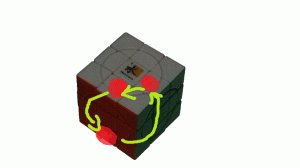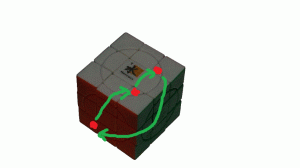
3x3x3 Mercury from mf8/dayan taken from twistypuzzles
Today I’m going to speak about the process I use to solve the Mercury Planet cube from the crazy 3x3x3 serie!
But first, here is a link to a video explaining how to do a ‘kit’ of all the planet cubes (and more) by buying only 2 puzzles:
I used that video to make my kit and am very happy with it!
This cube has one 1 face, for this tutorial I put it on the white one (this will be important for my commutators to know which face is 1 and which are 0), and all the other faces are 0 faces.
For more infos: http://twistypuzzles.com/cgi-bin/puzzle.cgi?pkey=2712
I’ll call outer 3x3x3 the pieces which you usually have on a 3x3x3 (the double sided edges, 3 sided corners and centers), circle edges the pieces of the circle beside the edges and circle corners the pieces of the circle beside the corner pieces.
Now we are ready to dive into the solve of this funny puzzle 😛
Strategy
I searched for some moves to do on this cube and came up with a strategy of my own. If you want you can exchange some of the steps because some are independent from all the others, so you can do it what way you prefer.
- solving the outer 3x3x3 edges
- placing/orienting the corners
- solving the circle edges
- solving the circle corners
Solving the outer 3x3x3 edges
By ‘solving the outer 3x3x3’ I mean solve the standard 3x3x3 edges (you can do corners at the same time but I found it to be quite confusing).
To do that you need only the algorithms you already know for the 3x3x3 (otherwise look at some other articles to find how to do it or try to do it by yourself first).
One important thing for this step is to notice that some of the circle edges can’t be moved (the ones beside the white and the yellow face).
My way of doing is to move them at the good spot and then doing the edge placement.
One difficulty you can encounter is the case with only on pair of edge and corrners exchanged (even permutation of corners and edges). To solve that problem, I do the algorithm we would usually do on a 3x3x3 with yellow or white in front.
Placing/orienting the corners of the outer 3x3x3
That step is dived into 2 which are quite independent from all the other steps. So you can do it at any time but I find it to be better there for recognition of the pieces in the next steps. First I place them using the usual 3x3x3 3-cycle of corners with yellow on top.
Then orientation is also done with yellow on top with the standard 3x3x3 last-layer corner orientation algorithms.
That step is very easy and fast, and even more if you already did some kind of F2L during the first step.
Solving the circle edges
This part is again independant from all the other moves so you could also for example place the circle corners before but once more, I find it easier for recognition.
Here comes the challenge. I have had to find a new commutator in order to solve that part of the cube.
I finally came up with a commutator that is pretty long (I imagine it’s not very efficient but I didn’t find another thing) but very easy to remember. I do this commutator with the white face on top.
here is a picture of the effect of that 3-cycle:
You can also notice my drawing abilities with paint :,)
Of course, you can mirror it / conjugate it to get other pieces to be exchanged.
Here it is:
[x,y]=[RL’FR’LD2L’RFR’L , U]
x will exchange 2 pieces, y prepares for undoing
Here is the ready to do sequence:
RL’FR’LD2L’RFR’L U L’RF’R’LD2L’RF’LR’ U’
With only that commutator, you should be able to solve all these circle edges.
My strategy is to solve red blue green orange circle edges first and finally white and yellow (just that I find it easier but you can do it another way).
You know are only one step away from a solved cube 🙂
Solving circle corners
Once again a step that I didn’t have any commutator for.
I figured out a new one, which I execute with white on top again. The setups can be sometimes quite hard to remember but it works 😛 .
Here is it’s effect:
[x,y] = [R’DRDFD’F’, U]
Final sequence:
R’DRDFD’F’ U FDF’D’R’D’R U’
Now you are able to solve the cube entirely! gratz 😉
Conclusion
This wasn’t an easy challenge for sure (even if there are tons of lot harder puzzles) but this is the pleasant thing of figuring out how to solve puzzles!
The only problem I have with my method is for some setups which makes me sometimes mess up the whole cube and I have to start again the solve.
I’ll maybe post some other planet solutions if I figure out to solve another 😉
Feel free to comment if you need help, I am not explaining everything in detail.


